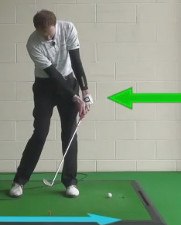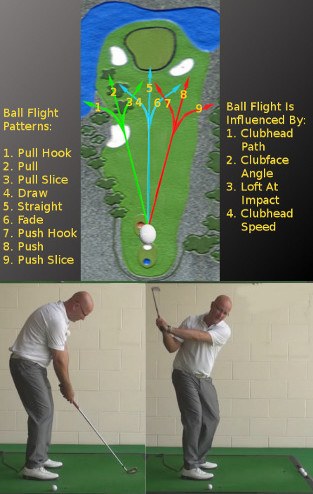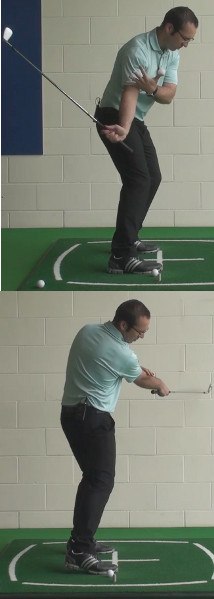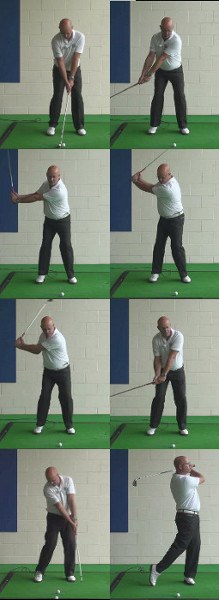
Many of golf's greatest players have relied on the fade – a softly curving left-to-right shot (for righties) – as their bread and butter. Ben Hogan, Jack Nicklaus and Lee Trevino are just a few of history's famous fade lovers.
In other words, amateurs who naturally fade the ball are in fine company. There are two potential problems, however. First and foremost, there's a fine line between a fade and its evil sibling, the slice. Second, a fade can easily degenerate into a pull, which starts left but does not curve back toward the target.

If you're a fader who sometimes lapses into a bout of the pulls, it means the clubface is square to your swing path, rather than the target line, at impact. Hence, you're not imparting the gentle sidespin needed to move the ball left-to-right.
The cause could be overactive hands. Your right hand is rolling too aggressively over the left, closing the clubface. Try this on the range:
- As you swing into the ball and through, keep the back of your left hand pointed at the target.
- Put another way, keep the left hand in front of the right, preventing the over-rotation at the root of your pulls.
Exaggerate this action for a few swings to get the hang of it. You may hit a few low pull slices, which means you're on the right track. You don't want to strangle the right hand from releasing altogether, so as you continue practicing, allow it to roll over the left after impact.

How to Stop Pulling Shots by Maintaining Face Angle at Impact
When you work on your golf swing at the driving range, you are probably concerned first and foremost with your ability to hit the ball straight. As in, you are trying to hit shots that don't curve dramatically in either direction as they fly. You don't want to hit a big hook, and you don't want to hit a big slice. If you can keep the ball flying in a generally straight direction, you should be in good shape. Right? Maybe not.
Hitting the ball without a significant amount of sidespin is one thing, but that doesn't automatically mean you will be hitting your targets. In some cases, you may find that you are hitting the ball relatively straight in terms of its flight pattern – but you are still missing the target line due to a poor launch direction. These shots are typically known as 'pushed' or 'pulled' shots. For a right-handed golfer, a pushed shot is one which flies directly out to the right of the target, while a pulled shot is one which misses to the left. In this article, we are going to address the issue of pulling your golf shots.
A pulled golf shot might be one of the most frustrating in the game. Why is this particular shot so difficult to accept? Simple – when you strike the ball, the shot usually feels great. The ball will come off the club sharply, and you will feel as though you have made excellent contact at the point of impact. Only when you look up to follow the ball will you see that it is not at all heading in the right direction. Even though it is technically flying straight, it is still getting farther and farther away from the original target line with each yard that it travels. When all is said and done, you may be left with a shot that isn't even close to the fairway or green. It should go without saying that you are going to need to eliminate the pulls from your game if you are going to lower your scores.
To hit shots that fly straight and actually hit the target, you are going to need to do a good job of controlling your face angle at impact. The content throughout the rest of this article is designed to help you achieve that goal. It isn't necessarily going to be easy, and the process will require you to spend plenty of time practicing before you are treated to positive results. If you are willing to stick with, however, you could come out on the other side as a vastly improved player.
All of the content below is written from the perspective of a right-handed golfer. If you happen to play left-handed, please take a moment to reverse the directions as necessary.

Creating a Pull
In order to fix your pull, you first need to have a clear understanding of why the ball is being pulled to the left in the first place. What kind of mistakes lead to this type of shot? What is happening with the club in order to hit a shot that flies mostly straight, but well to the left of the target?
We are going to answer the second question first. In order to hit a pull, you need to swing through on an outside-in path with a club face that is closed relative to the target line. That's it. If you meet those conditions, you will pull the ball to the left of the target. Of course, an outside-in swing path is also associated with another ball flight problem – the slice. In fact, the slice and the pull are closely related. The only difference between these two shots is the angle of the face at impact. If the face open, you will hit a fade or a slice (depending on the exact position of the face). If the face is closed, you will hit a pull. It should be no surprise that many golfers who struggle with the slice will also hit plenty of pulls along the way.
So, you now know what it is that causes the ball to be pulled to the left. It is the simple combination of an outside-in swing path and a club face which is closed relative to the target line. The next piece of the puzzle is to determine which swing mistakes are likely to lead to that outcome. Check out the points below for thoughts on this matter.
- Poor body rotation. This just may be the leading cause of pulled shots in the amateur game. When we refer to body rotation in the context, we are talking about the rotation of the body toward the target in the downswing. As the club swings down, you need to do a good job of turning your lower body toward the target aggressively. With an aggressive lower body turn, the rest of your body is going to follow along naturally until the club has whipped through the hitting area. If you fail to turn correctly, the club is going to be forced to the outside of the line because it will have nowhere else to go. Now that it is outside the proper path, you will have to swing across the ball at impact. If you combine this mistake with active hands (to close the club face), you are going to hit a pull. As you learn more and more about golf technique, you will find that poor body rotation is the root of many evils. Learn how to use your body correctly throughout the swing and you will be surprised to find how quickly your game can improve.
- Overactive hands throughout the swing. It is only natural to use your hands aggressively during the golf swing. After all, your hands are the only point of contact between your body and the club, so shouldn't they be involved in the task of moving the club? No, not really. Sure, they are going to play a role to some degree, but not as much as you might think. You need to limit the influence that your hands have over the movement of the club, both at the start of the swing and through the hitting area. When your swing is first getting started, you need to let your shoulders turn the club away from the ball while your hands remain passive. Then, as you swing down into impact, you should be using your body turn (as mentioned above) to bring the club through the hitting area. Your right hand will fire at the bottom of the swing as well, but it is best to let that happen naturally as opposed to trying to make it happen. Most players will find that their ball striking improves, and their pulls disappear, when they learn how to take hand action out of the swing for the most part.
- Incorrect ball position. For some players, the root cause of their pulls is as simple as placing the ball too far forward in their stance. If you play the ball up near the front of your stance – especially with your short clubs – you are going to run the risk of catching the ball when the club is moving on an outside-in path. Again here, you could create either a slice or a pull, depending on the position of the club face. Either way, you will not be happy with the outcome of the shot. Worse, you might think that there is a problem with your swing mechanics, rather than just your ball position, so you may wind up making technical changes that will only increase your troubles.
There are numerous ways in which you can wind up hitting a pull. Hopefully, you now have a clear picture of what it is that causes the ball to be pulled to the left, and what you can do about it. With this groundwork out of the way, we are going to walk through some instruction in the next section which we hope will break you out of your pull habit once and for all.

Getting Down to Work
As you would certainly expect, the best thing to do when you hope to fix a pull is to head to the driving range and get down to work. It is great to read instruction articles like this one on the web, but nothing about your swing is going to get fixed while sitting on the couch. Once you pick up the information you need to make changes, it is then up to you to take action.
The first thing you should do when you get to the driving range is hit a series of shots with a variety of clubs, without trying to make any changes at all. This is going to help you determine the severity of the situation. Are you hitting a pull with nearly every shot, or only once in a while? Hit a few shots with your driver, a few with a middle iron, and a few with a short iron. Watch the results of those shots closely and decide just how bad this pull problem really is.
If you are pulling a majority of your shots, there is likely a major problem in your golf swing. Those balls aren't being pulled to the left by accident or bad luck – you are doing something to cause them to move in that direction. But what is the root cause? The best way to get an answer to that question is to turn to video for assistance.
In this day and age, nearly everyone has a video recording device built right into their cell phone. In fact, you probably have a device capable of recording video within arm's reach right now. Use that device during your practice session to record some videos of you swinging the club. You can ask a friend to do the recording for you, or you can find a way to position your camera to record the action on your own. Either way, watching these videos back is going to be a powerful way to determine the root cause of your pulls.
When watching the video, keep in mind what you have learned from earlier discussion in this article. Are your hands working too actively during the swing? Is your lower body falling short of its duties in the downswing? You will likely need to watch your swing recording over and over again in order to determine the true identity of the problem. If your device has a function which allows you to watch videos back in slow motion, you may want to give that a try as well. Commit some time to the study of your swing and eventually the underlying cause of the pulls will make itself clear.
Now that you have clarity with regard to the problem, you can do your best to make the necessary changes. For example, let's say that you have determined your lower body is not working properly in the downswing. With that knowledge, you can focus on lower body action during your upcoming practice sessions. In time, your lower half should improve its performance during the swing, and your pulls should start to disappear. Sure, this is going to take some time, but you will be satisfied with your progress in the long run.

Stability in Your Left Wrist
We have not yet talked about your left wrist specifically in this article, but that is exactly what we are going to cover in this section. The stability of your left wrist is going to have a lot to do with whether or not you are able to eliminate your pulls. At impact, you need your left wrist to hold up in a mostly flat position as the club strikes the ball. If that left wrist breaks down at all – specifically, if it bows out toward the target – you will be at risk for hitting a pull.
The important thing to understand here is that your left wrist is going to closely mirror the position of your club face during the swing. Those two components are going to match up for the most part at address, and that needs to be the case again when impact rolls around. If your left wrist is out of position, you can plan on your club face being out of position as well. For many golfers, it is helpful to think about the swing in this way, as it is easier to tell what your left wrist is doing than to track the position of the club face all the way through the swing.
To work on maintaining a stable left wrist through impact – and a stable club face as a result – you can start out by hitting some short shots with your left-hand only. Head to the practice chipping area and pitch a few balls up onto the green while only holding onto the club with your left hand. At first, this is going to be quite the difficult task. You will probably allow your left wrist to fold up as you swing through, and you'll have trouble striking solid shots. It shouldn't take long, however, for you to get the hang of this challenge. You'll start to notice that placing your left wrist in a flat and firm position at impact is a great way to create a solid strike. This is the same idea that you want to use when hitting full shots. Find a flat left wrist position at the point of contact and it will be quite hard to create a pull.
From your short one-handed swings, gradually work your way up by making bigger and bigger swings (with two hands on the club, of course). You don't need to rush right into hitting your driver, as making such a big and aggressive swing is likely to force you back into some bad habits. Take your time and develop added comfort with this firm left wrist position as you move along. Before long, you will be able to make big swings with your long clubs and there won't be any hint of a pull in sight.

Making Your Way Around the Course
By now, you should have plenty of information related to the pull that may be plaguing your game. You should be moving in the right direction toward a solution to this problem, but it is going to take some time before you don't really need to worry about hitting a big pull anymore. So what do you do in the meantime? How do you get around the course while always thinking about the pull in the back of your mind? This last section will be dedicated to helping you play respectable golf despite having to deal with the pull hanging over your head.
The first thing to think about is the likely outcome of your swing given the shot at hand. We already know that the pull and the slice are closely related. If you have a tendency to hit pulled shots, you probably are prone to hitting slices as well. With that in mind, you are going to have to somehow guard against both sides of the golf course. You don't want to hit a pull because that shot will miss left, but a slice is going to cause you to miss right. So where do you aim? How are you going to guard against both sides of the golf course at the same time?
The answer is found in the club you are holding. If you are swinging a short iron, it is very unlikely that you will hit a slice. There is simply too much backspin, and not enough sidespin, for a shot played with a short iron to slice in any meaningful manner. Therefore, you can plan your shot around the possibility of a pull without much worry at all of a slice. In other words, you will probably want to aim for the right half of the green. If your shot flies straight, you are in good shape, and even a pull will have a chance to catch the putting surface. Aiming to the right is okay in this case because you probably won't slice your short irons.
Of course, the story is different with a club like the driver. There is much more sidespin which will be created on a driver shot as opposed to a short iron, meaning the potential for a slice is very real. In this case, it is the slice that is the bigger threat, so you will want to favor the left side of the fairway with your aim. Yes, a pull could lead you into the left rough, but that would be better than aiming down the right and then slicing the ball off the course entirely. You have to weigh the pros and cons of each potential outcome and choose the path that is marked with the least danger.
As you move along, you will find that you start to notice ball flight patterns changing as you make progress with your swing. When that begins to happen, you will want to respond to those changes in order to create an on-course strategy which is likely to lead to lower scores. You can never get too comfortable in this game, as the specifics of your shots will always be changing. Pay close attention and make smart decisions at every turn.
Hitting pulled golf shots is certainly frustrating, but it does not have to be a life sentence. You can fix this problem, as long as you are willing to be honest with yourself about the current shortcomings of your technique. Get down to work on this issue as soon as possible and you will be able to look forward to a future filled with quality golf shots. Good luck!






